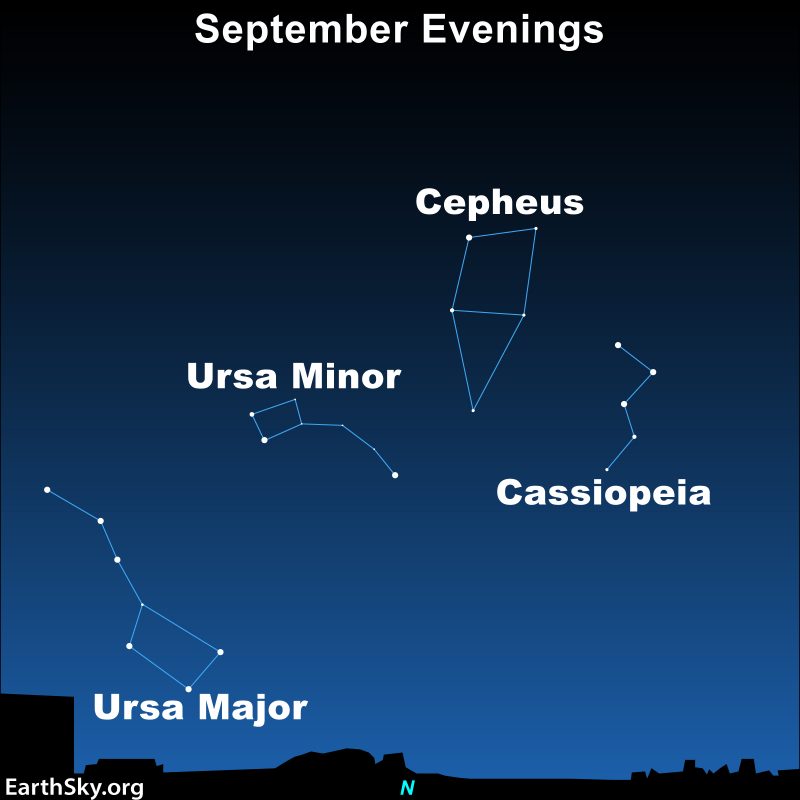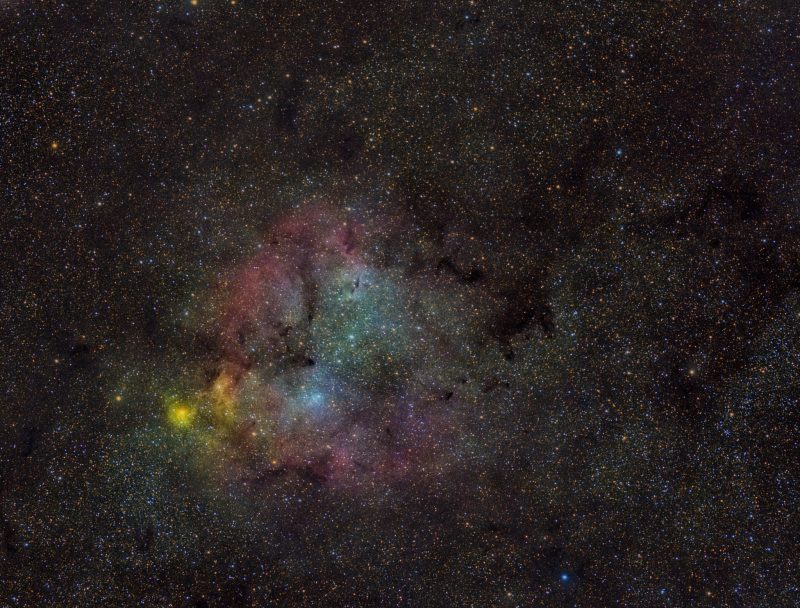
Cepheus the King
When seasoned stargazers look for the constellation Cepheus the King, they search for a five-sided pattern of stars that resembles a child’s drawing of a house. Sometimes this stick house is right side up. And at other times it appears to stand on its side or roof. Cepheus is far to the north on the sky’s dome. Plus, it lies adjacent to Polaris, the North Star. It’s also near the northern asterism of the Little Dipper, in the constellation Ursa Minor. In fact, you can use Polaris and the Little Dipper to find Cepheus.
From about latitude 40 degrees north, Cepheus is circumpolar. That is, it never rises or sets, but is always visible in the northern sky. And for those on the northern part of Earth’s globe, the King swings around the North Star and is visible all night long, all year long.
Cepheus may be found by drawing a triangle between the familiar Little Dipper asterism, the W-shaped constellation Cassiopeia, and the cross-shaped constellation Cygnus the Swan (aka the Northern Cross). Inside that triangle, you’ll find a pentagon (five-sided figure) of stars. This pentagon is Cepheus.
Or if your sky is dark enough, look for the stick house between the Little Dipper and Cassiopeia.
Finder charts for Cepheus


Mythology of the King
Cepheus – named for an ancient king of Ethiopia – figures in one of the most intricate legends of the night sky. His legend involves many nearby constellations. Cassiopeia the Queen represents the wife of Cepheus. She’s seen as seated beside him in the sky. The constellation Andromeda the Princess or Chained Lady resides in the sky on the other side of Cassiopeia.
According to the myths, Andromeda’s parents chained her up and presented her as a sacrifice to the sea god Poseidon. But as the sea monster Cetus was on its way to devour Andromeda, Perseus the Hero rode in on Pegasus the Winged Horse. Perseus saved Andromeda from the sea monster, the pair eventually married, and Perseus eventually became the king of Mycenae.

The stars of Cepheus
The brightest star in Cepheus isn’t very bright. It’s the 2.45-magnitude star Alpha Cephei, aka Alderamin. It shines at the bottom right corner of the house shape, if you consider the house as upright. Alderamin lies 45 light-years away. The other star forming the bottom of the upright house shape is 3.39-magnitude Zeta Cephei. It lies a much more distant 726 light-years away.
The star above Zeta Cephei that marks the top of the left-hand wall on the house (when upright) is Iota Cephei. Shining at magnitude 3.50, it lies 115 light-years away. The star that marks the top of the right-hand wall of the house is the 3.23-magnitude star Alfirk, or Beta Cephei. Alfirk is 595 light-years from Earth.
The star at the point of the roof in Cepheus is Gamma Cephei, or Errai, at magnitude 3.21. Like Alderamin, it lies 45 light-years distant. Because Earth wobbles as it spins, Errai will take the title of North Star from Polaris in about 2,000 years.
One other important star of note that isn’t part of the five stars that complete the image of the house is Delta Cephei. This variable star helped astronomers crack the code to measuring cosmic distances. An entire group of stars, the Cepheid variables, get their name from Delta Cephei.

Deep-sky targets in Cepheus
The Milky Way flows through the bottom half of Cepheus the King. Although there are star clusters in this part of the sky, none of them are particularly well-known. However, one interesting area for telescopic viewing can be found just below a line drawn to connect the bottom of the house shape. This area is called IC 1396, or the Elephant’s Trunk nebula. Through a telescope, first find the reddish star Mu Cephei. This behemoth star has the nickname of the Garnet Star. It’s a semi-regular supergiant that varies in brightness from magnitude 4.5 to 3.5 over the course of two years. Below Mu Cephei look for a cluster of stars and nebulosity that heralds the Elephant’s Trunk.
In addition to the Elephant’s Trunk, another area of Cepheus that provides good telescopic viewing is NGC 7023, or the Iris nebula. It lies 6 degrees up from Alpha Cephei and 3 1/2 degrees down from Beta Cephei, plus a little to the right from a line drawn between those two bright stars. Here you will find NGC 7023, a 7th-magnitude star glowing from within its cocoon of gas and dust, creating a lovely reflection nebula.
The last deep-sky stop in Cepheus involves two star clusters that lie approximately 1 degree away from Zeta Cephei and from each other, forming a tight triangle. The brighter of the two is the magnitude-7.7 cluster NGC 7235. The other shines at magnitude 8.4. It’s the cluster NGC 7261. These two star clusters are the start of a trail of clusters and nebulae that zigzag along the Milky Way toward Cassiopeia.
Some Cepheus deep-sky photos from our EarthSky Community


Bottom line: The constellation Cepheus the King is visible from the Northern Hemisphere every night of the year due to its close location to Polaris, the North Star.











